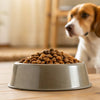Can I Mix Wet and Dry Food for My Dog? Exploring the Benefits and Best Practices
- Houndsy
Table of Contents
- Introduction
- Understanding Wet and Dry Dog Food
- Benefits of Mixing Wet and Dry Dog Food
- Potential Drawbacks of Mixing Wet and Dry Dog Food
- How to Mix Wet and Dry Dog Food
- When to Consider Mixing
- Conclusion
Introduction
Did you know that approximately 40% of dog owners mix wet and dry food for their pets? This trend has grown alongside the awareness of pet nutrition and the desire to make mealtime more exciting for our furry companions. If you've ever wondered, "Can I mix wet and dry food for my dog?" you're not alone! The practice of combining these two food types has become increasingly popular, not just for the variety it offers but also for the potential health benefits it can provide.
In this blog post, we will explore the intricacies of mixing wet and dry dog food, providing insights into why this method might be beneficial for your pet. We'll delve into the advantages and disadvantages, practical tips for mixing, and how to ensure that your dog's nutritional needs are met. By the end of this article, you'll have a comprehensive understanding of how to enhance your dog's feeding experience and the best practices for doing so.
As we embark on this exploration of mixed feeding, we invite you to reflect on your current pet feeding routine. Are you ready to elevate your dog's mealtime experience? Let's dive in!
Understanding Wet and Dry Dog Food
What is Dry Dog Food?
Dry dog food, also known as kibble, is the most common option and typically contains less than 12% moisture. Its long shelf life, ease of storage, and cost-effectiveness make it a popular choice among pet owners. Additionally, the crunchiness of kibble helps to promote dental health by reducing plaque buildup as dogs chew.
What is Wet Dog Food?
In contrast, wet dog food contains a significantly higher moisture content—usually between 75% and 78%. This type of food can come in various forms, including pates, chunks in gravy, or even shredded meat. Wet food is often more palatable for dogs, making it an excellent option for picky eaters or those with dental issues, as it requires less chewing.
Benefits of Mixing Wet and Dry Dog Food
Combining wet and dry dog food offers several notable benefits that can enhance your dog's overall health and happiness.
1. Increased Palatability
One of the most compelling reasons to mix wet and dry food is to make meals more appealing. The enticing aroma and texture of wet food can encourage even the pickiest eaters to finish their meals. If your dog has been turning their nose up at their kibble, a little wet food may just do the trick!
2. Enhanced Hydration
Many dogs, especially those on strictly dry diets, may not consume enough water. Mixing in wet food can significantly increase their overall hydration levels. This is particularly beneficial for dogs prone to urinary tract issues or those with specific health conditions that require increased fluid intake.
3. Nutritional Balance
Combining both food types can provide a more balanced diet. Dry food typically contains essential nutrients and vitamins, while wet food can offer additional protein and hydration. By mixing the two, you can ensure your dog receives a broader spectrum of nutrients.
4. Variety and Satisfaction
Just as we enjoy variety in our meals, dogs appreciate it too! Mixing wet and dry food can introduce new textures and flavors into your dog's diet, making mealtime more exciting and satisfying.
5. Cost-Effectiveness
While wet food can be more expensive than dry kibble, mixing the two can help stretch your budget. By using a smaller portion of wet food mixed with dry kibble, you can still provide flavor and hydration without significantly increasing your food costs.
Potential Drawbacks of Mixing Wet and Dry Dog Food
While mixing wet and dry dog food has its advantages, there are also potential drawbacks to consider:
1. Increased Waste
Opening a can of wet food means you must use it within a few days or refrigerate it, which can lead to waste if your dog doesn't finish it in time. Additionally, mixed meals can spoil faster than dry food alone.
2. Messy Feeding
Wet food can be messier than dry kibble, potentially leading to a more challenging cleanup process. If your dog tends to be messy when eating, this is an important consideration.
3. Nutritional Imbalance
It's essential to ensure that mixing wet and dry food does not lead to an unbalanced diet. Too much wet food can lead to excessive calorie intake or a lack of essential nutrients if not properly managed.
4. Cost Implications
While mixing can be cost-effective, consistently adding wet food to your dog's diet can still increase your overall food expenses. It's essential to find a balance that works for your budget.
How to Mix Wet and Dry Dog Food
If you've decided to try mixing wet and dry food for your dog, here are some practical tips to ensure a smooth transition:
1. Start Slowly
Introduce the mixture gradually. Begin by adding a small amount of wet food to their dry kibble and observe how your dog reacts. This helps prevent any digestive upset and allows your dog to adjust to the new flavor and texture.
2. Monitor Portions
A general guideline is to aim for a ratio of 75% dry food to 25% wet food. However, this can vary based on your dog's specific needs, age, and health conditions. Always consult your veterinarian for personalized recommendations.
3. Consider Your Dog's Preferences
Every dog is unique, and their preferences will vary. Some dogs may love the combination, while others may prefer one type over the other. Experiment with different ratios and brands to find what works best for your pup.
4. Keep It Fresh
Ensure that you store any opened wet food properly to maintain its freshness. If your dog doesn't finish the meal within a couple of hours, it's best to discard any leftovers to prevent spoilage.
5. Consult Your Veterinarian
Always consult your veterinarian before making significant changes to your dog's diet, especially if they have specific health concerns or dietary restrictions. Your vet can provide tailored advice on mixing wet and dry food safely.
When to Consider Mixing
While mixing wet and dry food can benefit most dogs, certain situations warrant particular attention:
1. Picky Eaters
If your dog tends to be a picky eater, introducing a mix of wet and dry food can entice them to eat. The aroma and texture of wet food may make their meals more appealing.
2. Senior Dogs
Older dogs may have dental issues that make chewing dry kibble difficult. Mixing in wet food can help soften their meals and make it easier for them to eat.
3. Dogs with Health Conditions
Dogs with specific health conditions, such as kidney disease or urinary issues, may benefit from increased hydration. Mixing wet food can help ensure they get the fluids they need.
4. Weight Management
For dogs needing to lose weight, incorporating wet food into their diet can help them feel full faster, promoting healthy weight loss. Conversely, for dogs needing to gain weight, mixing dry food with wet options can increase calorie intake.
Conclusion
In summary, mixing wet and dry food can enhance your dog's mealtime experience, providing numerous benefits, including improved palatability, hydration, and nutritional balance. However, it's essential to approach this mixing with care, ensuring that your dog's diet remains balanced and that you monitor their preferences and health needs.
As dog lovers, we at Houndsy understand the importance of creating a feeding routine that is both enjoyable and healthy for our pets. Our Houndsy Kibble Dispenser is designed to simplify the feeding process, ensuring that your dog receives the right portions every time (Order Now: https://houndsy.com/products/houndsy-kibble-dispenser). By combining our innovative design with your feeding strategies, you can elevate your dog's feeding experience and make mealtime a joyous occasion.
FAQ
Can I mix wet and dry food for my dog?
Yes, mixing wet and dry food is safe and can offer numerous benefits, such as increased palatability and hydration.
What ratio of wet to dry food should I use?
A common guideline is 75% dry food to 25% wet food, but this can vary based on your dog's specific needs.
Will mixing wet and dry food affect my dog's dental health?
While wet food may not provide the same dental benefits as dry kibble, regular dental check-ups and cleanings can help maintain your dog's oral health.
How should I store leftover wet food?
Once opened, wet food should be refrigerated and used within a few days to prevent spoilage.
Can all dogs benefit from mixed feeding?
Most dogs can benefit from a mixed diet, but always consult your veterinarian if your dog has specific health conditions or dietary restrictions.













